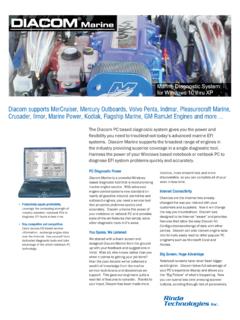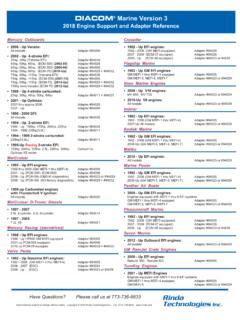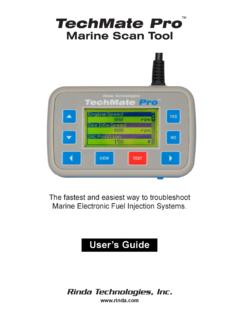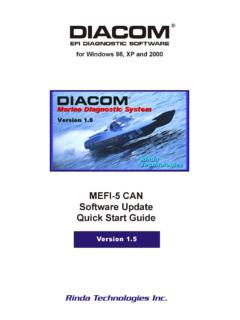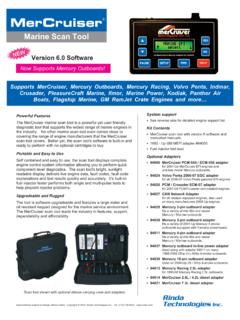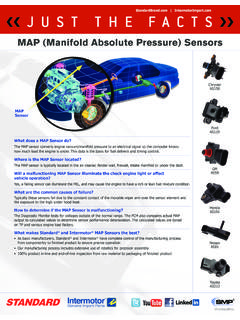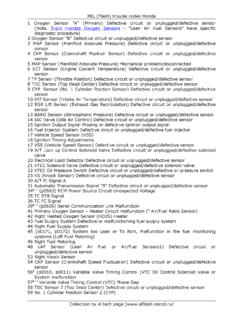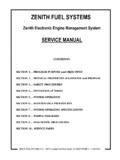Transcription of EFI Connections 03 - Rinda
1 EFI Connections3 Marine fuel injection technology has comea long way since the introduction ofGeneral Motors MEFI-1 engine controllerback in 1992. The newest GM systemsoffered by marine manufacturers packmore features, have more computingpower and control engine performancemore precisely than ever before. While thesophistication of these engine controlsystems has increased dramatically overthe past decade, the fundamentals of howthey work (and what to look for when theydon t) still remain essentially the article reviews the basic concepts ofhow GM MEFI fuel injection modulesoperate in an attempt to increase yourdiagnostic and troubleshooting order to properly run an engine, MEFI control modules rely on a handful ofengine sensors as well as pre-programmedfuel and spark control information that isstored in the module s memory.
2 Marinemanufacturers develop this information byrunning their engines through a series ofload and performance tests to create acomputerized profile for each engine profile, also known as an enginecalibration , instructs the MEFI module todeliver the correct fuel and spark amountsfor all possible engine operatingconditions. Knowing the basics of how themodule uses this calibration and sensorinformation is the key to efficientlytroubleshooting MEFI fundamentals of fueling an enginehave not changed since the days of thecarburetor. For the most part, the greaterthe load an engine is placed under the morefuel it needs. Opening the throttle plateon a carbureted engine allowed more air toflow into the intake manifold along withmore fuel.
3 The fuel was essentiallyvacuumed out of the carburetor s jets inproportion to the intake air flow. MEFI controlled engines by contrast must sensethe amount of load an engine is under, aswell as determine other factors, and then inject the proper amount of fuel to runthe engine first glance, one might think thatsensing how far the throttle plate wasopened might be a good indicator fordelivering the proper amount of fuel. steady runningconditions, when you re not rapidlyaccelerating or decelerating, the ThrottlePosition Sensor readings have little to do indetermining the correct amount of fuelneeded to run an engine. Later in thisarticle we ll see how the TPS is used by theMEFI module but for now, it s time to turnour attention MEFI control modules contain one ormore numeric tables in their memory thatspecify how much fuel should be deliveredbased upon engine load.
4 While MEFI modules have continually advanced overthe years and use increasinglysophisticated fueling strategies, thefollowing fundamentals still apply: Engineload is primarily determined by sensing thecurrent engine speed and reading themanifold pressure via the MAP MEFI module uses RPM and MAP toselect data from a table with rows andcolumns of numbers that represent injectorpulse width values (milliseconds ofon-time). When the ECM needs to knowhow much fuel to deliver it reads the MAPand RPM, then it refers to thecorresponding row and column in its fueltable to obtain the correct injector pulsewidth, also known as the base pulsewidth.
5 Once this pulse width value isobtained there are adjustments made to itbased upon other engine operatingconditions, however MAP and RPM arethe main factors involved in selecting thebase value. As you can see, if for somereason the MAP sensor was providingfaulty information ( bad sensor) theengine s load would be misinterpreted andas a result it would not be fueled is a good place to point out that theengine s spark advance is also selected in asimilar fashion. Again, there is a table inthe ECM s memory with rows andcolumns of numbers that specify degreesof advance. The desired advance value ischosen based upon RPM and MAP. Oncethe desired spark advance is obtained,other operating conditions are evaluatedand used to adjust the these fundamental concepts statedyou might ask how all of the other enginesensors come into play?
6 In addition to aMAP sensor, MEFI systems typicallyinclude sensors for throttle position,coolant temperature, and knock , depending upon the engine model,the system may include sensors formanifold air temperature and fuel of these sensors play a vital role inengine operation and are used by the MEFI module to sense a variety of operatingconditions. The following paragraphs willattempt to provide a basic understanding oftheir primary throttle position sensor (TPS) isprobably the most misunderstood of allengine sensors. While readings from thissensor are important in determining idleand wide open throttle conditions(eliminating the need for mechanicalswitches), it s main purpose is to provideinformation related to engine accelerationand deceleration.
7 Under normal runningconditions, above idle and less than fullthrottle, the MEFI module uses TPSreadings to sense if the operator is trying torapidly accelerate or decelerate. It doesTROUBLESHOOTINGU nderstanding MEFI OperationMEFI Injector Pulse Width Table4 EFI from page 1diagnostic tool (MerCruiser / TechMatescan tool or Diacom PC software). Thiseliminates the need to unbolt the MEFI module and check it s part number whichis located on the module s bottom has taken a completely newdirection in engine control with theintroduction of their PCM-555 propulsioncontrol module. Designed by MercuryMarine and manufactured by Motorola,PCM-555 forms the foundation ofMercury s SmartCraft vessel managementsystem.
8 Sometimes referred to by industryinsiders as the Triple Nickels module,PCM-555 and it s smaller brotherECM-555 now supplant all GeneralMotors MEFI control modules on newlymanufactured MerCruiser gasoline technicians familiar with priorGM MEFI systems should note that thesenew Mercury modules require differenttroubleshooting procedures and updateddiagnostic tool software for properdiagnosis and service. PCM-555 andECM-555 are unique to Mercury Marineproducts. Currently, PCM-555 is installedon all MerCruiser 496 cid V8 sterndrivesand inboards. ECM-555 can be found onall other MerCruiser EFI Marine s ECM-555 Engine Control ModuleMercury Marine s PCM-555 Propulsion Control Modulethis by determining how much the TPSvoltage has changed since the last time thevalue was read.
9 The sensor s absoluteposition and corresponding voltage are lessimportant than the amount it has MEFI module reads the TPS voltageevery few milliseconds and calculates thedifference between the current and lastreadings. If a large enough change isdetected, adjustments are then made to thefuel injector s base pulse width value toprovide extra fuel for rapid acceleration or adecrease in fuel for deceleration. Again, theexact TPS voltage is important at idle orwide open throttle, however during normalrunning conditions it s the change and rateof change in TPS voltage that matters coolant temperature sensor (CTS)provides important fueling information tothe ECM when the engine is below it snormal operating temperature.
10 Coldengines require more fuel to operate so theECM uses the CTS information to enrich theair/fuel mixture in much the same way anautomatic choke did on carbureted upon how cold the engine is, theMEFI module will increase the base pulsewidth values obtained from it s main fueltable and then gradually taper off theincrease as the engine warms up. The CTSis also used for several other temperaturedependent purposes including themodification of idle speed, IAC motorposition, and spark advance as well asdetecting engine overheat far we have reviewed some of the mainfactors and sensors involved in fueling anengine correctly. Another important aspectis providing correct spark advance andcontrol.
